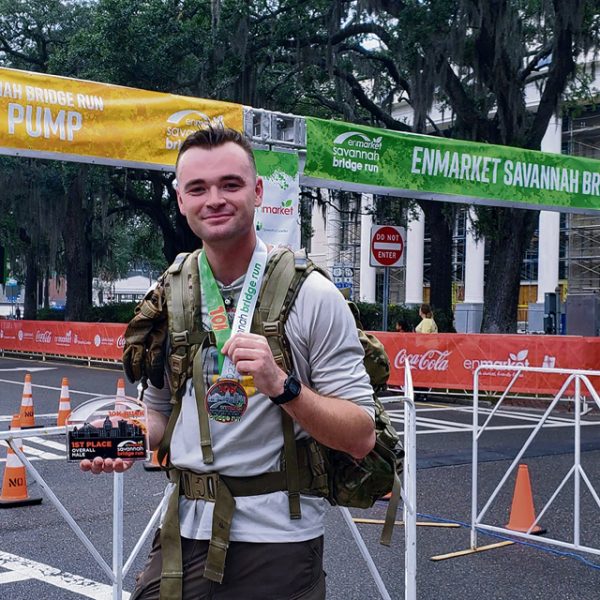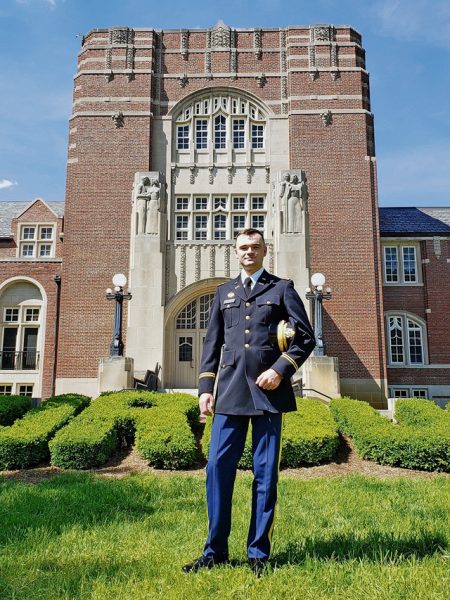
A high-speed U.S. Army Chemical Corps officer took first place in the ruck division of the 10-kilometer Enmarket Savannah Bridge Run in Savannah, Georgia.
U.S. Army 1st Lt. Brian M. O’Leary, the team leader of the Chemical, Biological, Radiological, Nuclear, Explosives Response Team 2 from the 25th CBRNE Company (Technical Escort), competed against 67 other athletes in the ruck division of the race.
O’Leary came in 30 seconds ahead of the second-place finisher during the race that went through historic downtown Savannah and across a steep bridge.
“The bridge run is something of an institution here in Savannah, so I had wanted to participate since I moved here,” said O’Leary.
The race took place on a cool morning with misty rain and heavy fog blanketing the historic city in coastal Georgia. The Savannah race had more than 4,200 competitors in all divisions.
The ruck division was much smaller, said O’Leary, a native of Zionsville, Indiana, who graduated from Purdue University in West Lafayette, Indiana, where he studied Engineering Technology and Philosophy.

“My division was a 10-kilometer ruck route crossing the Talmadge Bridge twice, a 1.4-mile span at a 5.5 percent grade over the Savannah River,” said O’Leary. “That doesn’t sound like much, but it’s the steepest hill around. Standing on top of the bridge with a ruck on my back, looking over the river and the city below was a surreal experience that I’ll remember for a long time.”
Commissioned in the U.S. Army in May 2021, O’Leary leads a CBRNE Response Team that saves lives and enables operations.
CBRNE Response Teams tackle a variety of challenging missions, including initial sampling, limited decontamination, packaging, escorting, detection, munitions assessment, explosive threat mitigation and contaminated sensitive site exploitation.
The Fort Stewart, Georgia-based CBRNE Response Team 2 is part of the 25th CBRNE Company, 83rd CBRN Battalion, 48th Chemical Brigade and 20th Chemical, Biological, Radiological, Nuclear, Explosives Command, the U.S. military’s premier CBRNE formation.

From 19 bases in 16 states, Soldiers and Army civilians from the 20th CBRNE Command confront and defeat the world’s most dangerous hazards in support of joint, interagency and multinational operations.
To forge stronger relationships with other units, O’Leary also recently organized the Norwegian Foot March on Fort Stewart, Georgia.
The Norwegian Foot March is an 18.6-mile, 25-pound rucksack march where participants who complete the march in the prescribed timeframe before dawn and work a full day after the march earn a Norwegian Armed Forces Skill Badge.
“We had 97 Soldiers attend from 20 units across Fort Stewart,” said O’Leary. “I was very pleased with the turnout. The goal of the event was to build relationships with units on post to help our Chemical Soldiers better integrate with and enable them when we train in the field. With so many units being represented, we built a lot of great relationships that should leave a lasting impact on the installation.”
Capt. Jose G. Matos, the commander of the 756th Ordnance Company (Explosive Ordnance Disposal), was the first-place finisher in the Norwegian Foot March with a time of 3 hours and 43 minutes. The 756th EOD Company is part of the 184th EOD Battalion, 52nd EOD Group and 20th CBRNE Command.
A graduate of Interamerican University of Puerto Rico who is from Guaynabo, Puerto Rico, Matos has served in the Army for eight years after serving in the U.S. Navy and Naval Reserves for eight years and deploying twice on the aircraft carrier USS Abraham Lincoln (CVN 72).
Demonstrating his commitment to physical fitness, O’Leary usually exercises twice a day, in the morning for physical training and again at the end of the day with a few of his Soldiers.
“While I’ve always had a passion for running, rucking and cycling, muscular strength and overall fitness were new challenges that the Army introduced to me,” said O’Leary. “When I joined ROTC, it took me a long time to get my fitness to a place that I could be proud of.”
O’Leary said physical fitness is critical to mission readiness in the U.S. Army, the world’s premier ground combat force.
“A fit body is the foundation of a strong Soldier,” said O’Leary. “Being fit means more than running fast and lifting heavy. It means living a lifestyle that allows you to sustain that level of strength for the long haul. Diet, sleep, stress management, injury recovery, and of course, strenuous exercise all play a factor.”
The CBRNE Response Team leader said his focus on fitness has helped him to set the example for his Soldiers and gives him experience to lean on when he is pushing them to improve.
O’Leary learned the importance of grit, tenacity and determination from firsthand experience.
A few years before commissioning, O’Leary broke his neck in an accident during an interstate cycling trip. He said the long road to recovery was a tremendous setback.
“Once I got clear of the restrictions the injuries brought, I attacked fitness with a new resolve; understanding how fragile life is has given me a new dedication to be as strong and as capable as I can,” said O’Leary. “Not long after the end of my recovery, I rucked my first 30 miler.”
O’Leary challenged other Soldiers to push themselves further than they think possible.
“For Soldiers who are trying to work on fitness, I’d say this: exercise is supposed to be uncomfortable,” said O’Leary, who hopes to attend Ranger School later this year. “I remember how hard it was to get into the gym for the first time or to push myself to get out and start my first long run. Remember that if you want to be something you’ve never been before, you need to get out and do something you’ve never done before.”


